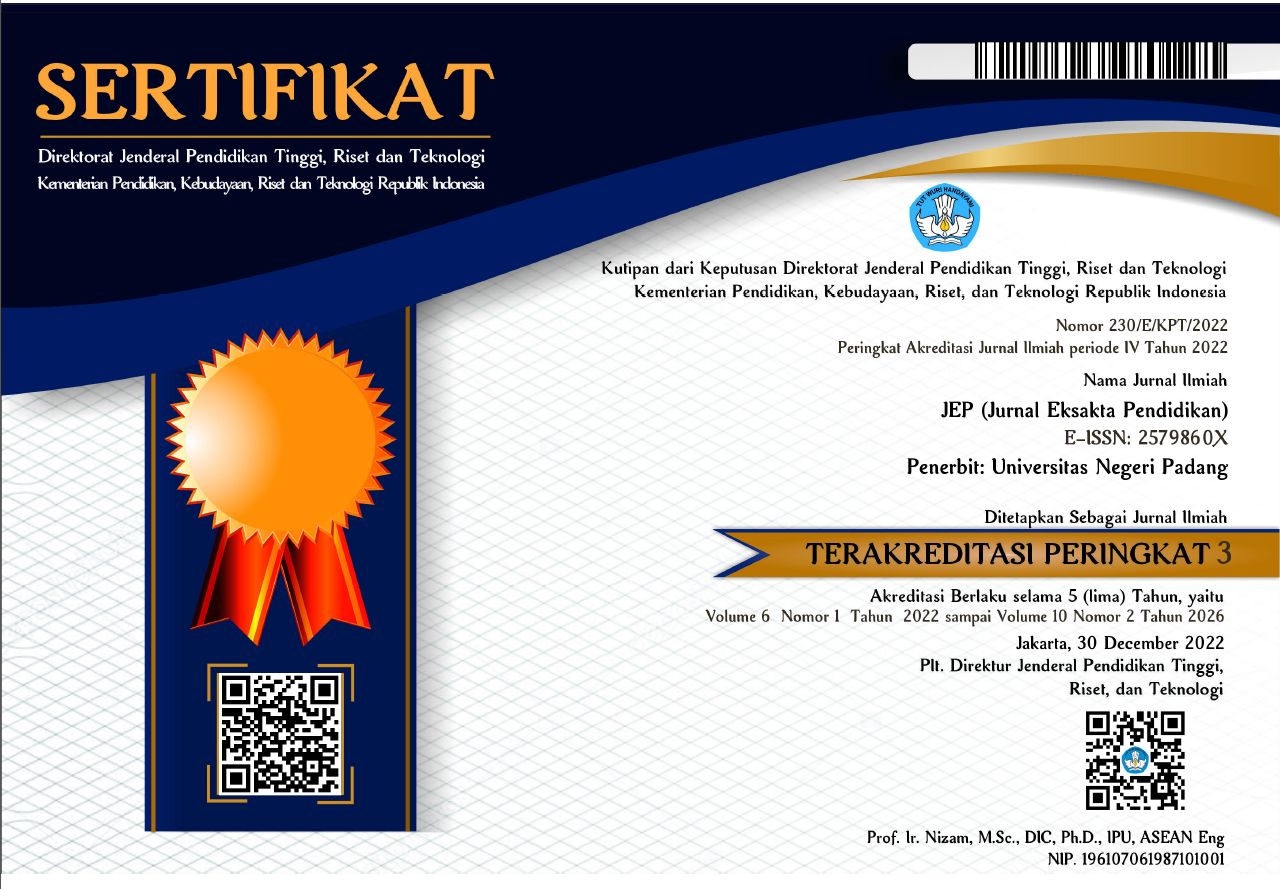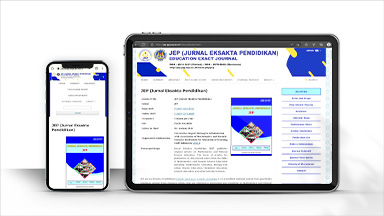Pengembangan Instrumen Penilaian Kemampuan Berpikir Tingkat Tinggi Materi Sistem Pendengaran dan Sonar SMP
Abstract
The aim of this study is to produce a higher-order thinking skills assessment instrument on the material of the hearing and sonar system for Junior high school students that are valid and reliable. Indicators of higher-order thinking skills (IKBTT) are developed based on the cognitive dimension of Bloom's Taxonomy which includes the skills to analyze (C4), evaluate (C5) and create (C6). The assessment instrument developed was a multiple choice test with open reasons. Multiple choice test with open reason is a multiple choice question with four answer choices completed with the reason for choosing an answer. The instrument is equipped with an assessment rubric in the form of a holistic rubric to assess the relationship between multiple choice answers and reasons for choosing answers. The results of the validation of material aspects, construction, and language show that the products developed are very feasible with an average score of 85.7%. The instrument was empirically tested with the number of subjects trying as many as 59 students of 8th grade Junior high school. Based on the results of empirical trials of multiple choice questions with open reasons obtained 25 valid questions with multiple choice reliability of 0.745, and reason reliability of 0.929. The number of questions produced based on C4 cognitive dimensions were 12 questions (48%), C5 cognitive dimensions were 9 questions (36%), and C6 cognitive dimensions were 4 questions (16%). This study produced an instrument for assessing higher-order thinking skills in the material of the hearing and sonar system for Junior high school students that were valid and reliable.
Downloads
References
Gloria, R.Y. 2012. Pentingnya Asesmen Al-ternatif Dalam Meningkatkan Kemam-puan Berpikir Dan Membaca Ilmiah Siswa Pada Pembelajaran Biologi. Jurnal Scientiae Educatia Volume 1 Edisi1.(online),(https://www. syekhnurjati.ac.id /jurnal/ index. php/ sceducatia/ article/view/ 502/440) diakses 20 Februari 2017
Herman, J.A., Aschbacher, P.R., & Winters, L. 1992. A Practical Guide to AlternativeAssessment.(online),(http: //files.eric.ed. gov /fulltext/ ED352389 .pdf) diakses 21 Januari 2017
Inteni, Candiasa, & Suarni. 2013. Pengem-bangan Instrumen Tes Objektif Pilihan Ganda Yang Diperluas Berbasis Web Untuk Mata Pelajaran Tik Kelas Xi Sman Di Kabupaten Karangasem. E-Journal Program Pasca Sarjana Uni-versitas Pendidikan Ganesha. (online), (http://journals.sagepub.com /doi/pdf/10.3102/0013189X020008015) diakses 21 Januari 2017
Istiyono, Mardaphi, & Suparno. 2014. Pe-ngembangan Tes Kemampuan Berpikir Tingkat Tinggi Fisika (Pysthots) Peserta Didik SMA. Jurnal Penelitian dan Evaluasi Pendidikan Tahun 18, Nomor 1, 2014. (online), (http://journal.uny. ac.id/index.php/jpep/article/view/2120) diakses 8 September 2016
King,FJ. M.S, Ludwika G., & Rohani. 2010. Higher Order Thinking Skills. (Online),(http://www.cala.fsu.edu/files/higher_order_thinking_skills.pdf) diakses 8 September 2016
Litbang Kemendikbud. 2013. Profil Kemam-puan IPA Peserta Didik Indonesia. (online)(http://litbang.
kemdikbud.go.id/data/puspendik/HASIL%20RISET/TIMSS/LAPORAN%20TIMSS%202011%20%20Profil%20Kemampan%20IPA%20Peserta%20Didik%20Indonesia%20(SMP%20Kelas%208)%20menurut%20Benchmark%20Internasional.pdf) diakses 22 Oktober 2016
Lisa, Prasetyo, A.P.B & Indiyanti, D.R. 2012. Pengembangan Instrumen Peni laian Ketrampilan Berpikir Tingkat Tinggi Materi Sistem Respirasi dan Ekskresi. Lembaran Ilmu Kependidikan Volume 41 (1) (2012). (online) (http://journal. unnes.ac.id/ artikel_nju/ LIK/ 2226) diakses 29 Oktober 2016
PISA. 2015. PISA 2015 Results in Focus What 15-year-olds know and what they can do with what they know. (online), (https://www.oecd.org/pisa/keyfidings/pisa-2012-results overview.pdf) diakses pada 21 Oktober 2016
Riduwan. 2006. Belajar Mudah Penelitian untuk Guru dan Pemula. Bandung: CV Alfabeta.
Rofiah, Aminah, & Ekawati. 2013. Penyu-sunan Instrumen Tes Kemampuan Berpikir Tingkat Tinggi Fisika Pada Siswa SMP. Jurnal Pendidikan Fisika (2013) Vol.1
No.2 halaman 17. (online), (http://www.jurnal.fkip.uns.ac.id/index.php/pfisika/article/view/2797/1913) diakses 8 September 2016
Sa’adah, Aliyatus., Sugiyanto dan Sutarman. 2014. Pengembangan Instrumen Tes Benar-Salah untuk Menilai Kemampuan Berpikir Tingkat Tinggi pada Materi Dinamika Rotasi dan Keseimbangan Benda Tegar. Artikel. (online) (http://jurnal.online.um.ac.id/data/artikel/artikel662F729E1D404633A7770C86049A5069.pdf) diakses 9 Desember 2016
Silver & Hmelo, Cindy E. 2004. Problem-Based Learning: What and How Do Students Learn? Educational Psychology Review, Vol. 16, No. 3, September 2004. (online) (http://kanagawa.lti.cs.cmu.edu/olcts09/sites/default/files/HmeloSilver_2004.pdf) diakses pada 11 Maret 2017
Sofiyah, S., Susanto, & Setiawani, S. 2015. Pengembangan Paket Tes Kemampuan Berpikir Tingkat Tinggi Matematika Berdasarkan Revisi Taksonomi Bloom Pada Siswa Kelas V SD. Artikel Ilmiah Mahasiswa, 2016, I (1): 1-7.(online), (http://repository.unej.ac.id/bitstream/handle/123456789/64108/SITI%20SOFIYAH.pdf?sequence=1), diakses 8 September 2016
Weiss, R.E. 2003. Designing problems to promote higher-order thinking. New directions for teaching and learning, 2003(95), 25-31. (online), (http: //utmlead.utm.my/wp-content/uploads /2014/08/Designing-Problems-to-Promote-Higher-Order-Thinking.pdf) diakses 22 Mei 2017

This work is licensed under a Creative Commons Attribution 4.0 International License.




_(2579-860X).png)
_(2614-1221)1.png)




